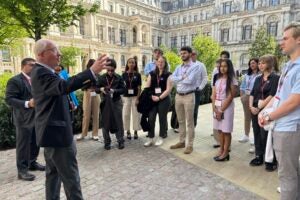AUSTIN, Texas—The Harry Ransom Humanities Research Center at The University of Texas at Austin has acquired the archive of photographer Arnold Newman (1918-2006), whose “environmental portraits” included Lyndon Baines Johnson, Pablo Picasso and Truman Capote.

|
| Arnold Newman Self-portrait, Philadelphia, 1938. |
|
Photo: Arnold Newman/Getty Images
|
Newman, who died June 6, is recognized as a master photographer of the 20th century, known for his “environmental portraits,” images taken in a subject’s personal or professional surroundings. Newman’s international subjects included world leaders, authors, artists, musicians and scientists.
The archive spans from the late 1930s to the 21st century and contains all of Newman’s negatives, slides and color transparencies, all of his original contact sheets and more than 2,000 prints, including examples of color and collage work. The archive also includes Newman’s original sittings books, correspondence and business files, early sketchbooks, photographic albums and some of the many awards he received during his lifetime.
“Newman is without question one of the celebrated masters of photographic portraiture of the 20th century,” said David Coleman, Ransom Center curator of photography.
Newman adopted a signature, and influential, approach of portraying his subjects with contextual clues to their life and work.
“His goal was to meld a striking composition with what was true to the sitter,” Coleman said. “His success is apparent because his portraits often come to mind when one recalls many of the icons of 20th century literature, art, science and politics.”
Among Newman’s notable portraits are: artist Picasso in his studio in France, Johnson as Senate Majority Leader, composer Igor Stravinsky sitting at the piano, poet Langston Hughes in Harlem, artist Donald Judd alongside one of his works, theoretical physicist Robert Oppenheimer at his desk, Capote lounging on his sofa and Otto Frank, father of Anne Frank, in the attic where his family hid from the Nazis for more than two years.
“The significance of this archive is wide-ranging,” said Thomas F. Staley, director of the Ransom Center. “With this acquisition we add to our collections not only the works and papers of a renowned photographer, but also important, revealing images of many of the 20th century’s most celebrated figures in culture, science and politics.”
The “Arnold Newman Fellowship in Photography” will be created to support scholarly research in the center’s photography collection, including study on the career and works of Newman.
“Through study of this unique archive, students and scholars will be able to trace Newman’s creative process of interpreting his subjects—from the germination of ideas at the portrait sitting, to their refinement via image selection and cropping, and to their ultimate realization in either published or printed form,” said Coleman.
Press images from the Newman archive are available.
View the photo gallery of works from the Newman archive.
For more information contact: Jennifer Tisdale, 512-471-8949; Alicia Dietrich, 512-232-3667, Harry Ransom Center.



